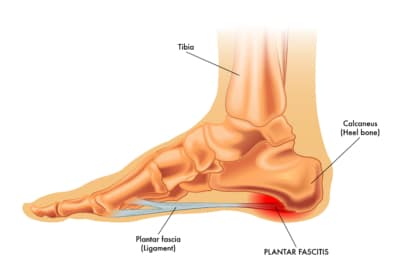Picture this – While exercising, you notice pain and a little stiffness in the bottom of your right foot. The pain starts off small, so you ignore it, but it continues to get worse over time. You take a couple days off, ice your foot, and resume exercising a few days later. Unfortunately, a familiar pain starts to return. To compensate for the discomfort on your right side, you begin shifting your weight to your left side. After a few days of these altered movement mechanics, you notice pain in both feet, as well as your left hip.
You decide your body just needs to rest. You refrain from exercising for a couple weeks, and continue to stretch and apply ice. Your feet begin to feel better, but the pain in your left hip still lingers as you go about your day-to-day activities. Because of the hip discomfort, your body naturally begins favoring the other side, which is putting additional pressure on your right foot, which is starting to hurt again…
This is often the vicious cycle of plantar fasciitis, which affects roughly 10 percent of the entire population at some point during their lifetime. The Spooner Physical Therapy Team wants to provide you with the knowledge you need to understand what plantar fasciitis is, how to recognize it, and what you can do about it!
What is Plantar Fasciitis?
 Your plantar fascia is a band of connective tissue that originates at your heel and connects to the base of your toes. It acts as an arch support and shock absorber, designed to reduce the impact and stress placed on the foot when we walk, run, or jump.
Your plantar fascia is a band of connective tissue that originates at your heel and connects to the base of your toes. It acts as an arch support and shock absorber, designed to reduce the impact and stress placed on the foot when we walk, run, or jump.
Over time, this support can begin to break down and strain, causing pain and inflammation in the bottom of the foot. The term “itis” means inflammation, so plantar fasciitis is simply inflammation of the plantar fascia ligament.
What are the signs and symptoms?
The most common symptom of plantar fasciitis is pain and stiffness in the foot, typically towards the heel bone. People with plantar fasciitis may experience this pain:
- In the first thing in the morning or after long periods of sitting
- After exercise as opposed to during exercise
- When barefoot or climbing stairs
- Standing for long periods of time
This pain and stiffness may be present in one or both feet, may be sharp or dull, and will develop gradually over time. Listen to your body and make sure you’re paying attention to the signs and symptoms so we can address any deficiencies before they become bigger problems for you.
What causes Plantar Fasciitis?
Although the definition and symptoms of plantar fasciitis may be simple, the factors that contribute to this condition are not as straightforward. Each of the following variables can influence the onset of plantar fasciitis:
- Increase in standing activities or running
- Strength and/or mobility deficits
- Improper gait and movement mechanics
- Age
- Poor footwear
- High-arching or flat feet
- Weight gain or pregnancy
It’s apparent that plantar fasciitis can be caused by a multitude of factors and conditions, so how are you supposed to know what you should be doing to alleviate your pain and discomfort? Well… that’s where we come in!
How Spooner PT Can Help
Everyone is different and has their own unique set of circumstances, which is why it’s so important to include your physical therapist in your recovery strategy! Our entire body is connected, and our physical therapists understand the importance of assessing your body as a whole to make sure everything is moving and functioning the way it should. We don’t treat symptoms, we treat the whole person and the movement patterns that contributed to the pain in the first place.
Don’t ignore your foot pain (or any pain) hoping it will get better on its own. Reach out to one of our many clinics throughout the Valley, and we’ll work together on getting your body moving and feeling the way it should!
Time to put your foot down on living with pain. Schedule an appointment or complimentary movement assessment, and let’s get you moving and feeling better today!

